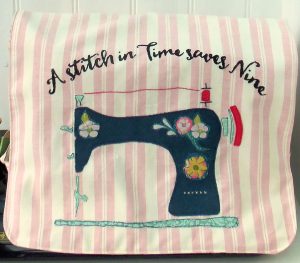
Filled with excitement and enthusiasm for your latest piece of work, it’s easy to forget about taking care of your essential sewing workhorse – your machine is a piece of equipment that’s often taken for granted even though it can easily be the most expensive item in your workspace. In our latest blog series we are going to be telling you all about some easy steps to keep your machine running smoothly so it’s always ready to take on another new project. And if things do go a bit wonky check out our hints and tips to get you sewing again!
> The simplest and easiest thing you can do to help keep your sewing machine in good shape is to make sure you cover it when it’s not in use! This will stop dust, lint and (especially in my home) pet hair from penetrating into the mechanics of your machine. Most machines come with a cover, though these are usually less than inspiring and it’s fun to make your own to suit your personal tastes.

Why not pretty up your machine with our applique cover? Find the pattern here
> Ideally you should clean your machine every so often, especially if you’ve been using textured fabrics as the main problem is lint – the short threads that are shed from the fabric you’re working with. Lint can easily build up and will attract dust too, clogging up the workings of your machine so it won’t work as efficiently and may even, if not brushed away regularly, contribute to long term damage.
> Along with regularly brushing away any build up of lint, you should also change your needle regularly. It’s a fact that most sewing machine stitching issues are caused by the needle. Continuing with a bent or blunt needle is very likely to result in skipped stitches, broken thread, or large loops in the stitches. It may also damage your fabric and even your machine. My mum always told me to change my needle after every project – this is a bit excessive I think and I usually aim for every eight hours of sewing. Be sure to choose a needle that’s right for the fabric you’re using. You should also change your needle if you change to a different kind of thread. This is because thread wears a groove in the needle eye and different brands will affect the needle in different ways.
> It’s also important to use the bobbin type recommended by your sewing machine manufacturer so that it runs smoothly in the case. Don’t be tempted to wind a new thread onto an already partially filled bobbin as this will create extra thread tails that can jam your machine. Sadly (I say sadly as I really winding bobbins), it’s best not to use pre-wound bobbins unless the manufacturer states this is OK. I have been tempted by them, but have never achieved good results. Ideally, if you use your sewing machine regularly you should have it serviced annually by a qualified technician. He or she will check and adjust the tension and timing as well as professionally cleaning the parts of the machine the user can’t access. Your machine will also be checked for wear and tear and any parts replaced as necessary. This should keep your indispensable asset running smoothly.
Sometimes, in spite of all your care and attention, you will experience problems with your machine. Check back next Friday when I’ll be talking about some of the most common problems and how to fix them.
Do you have any top tips for looking after your sewing machine? Leave them in the comments below, we’d love to know!
We share lots more hints, tips and goodies with our newsletter readers, so if you’d like to be the first to hear all our news, just click the button above to sign up – it’s free and we never share your email address with anyone else – promise!

Leave a Reply